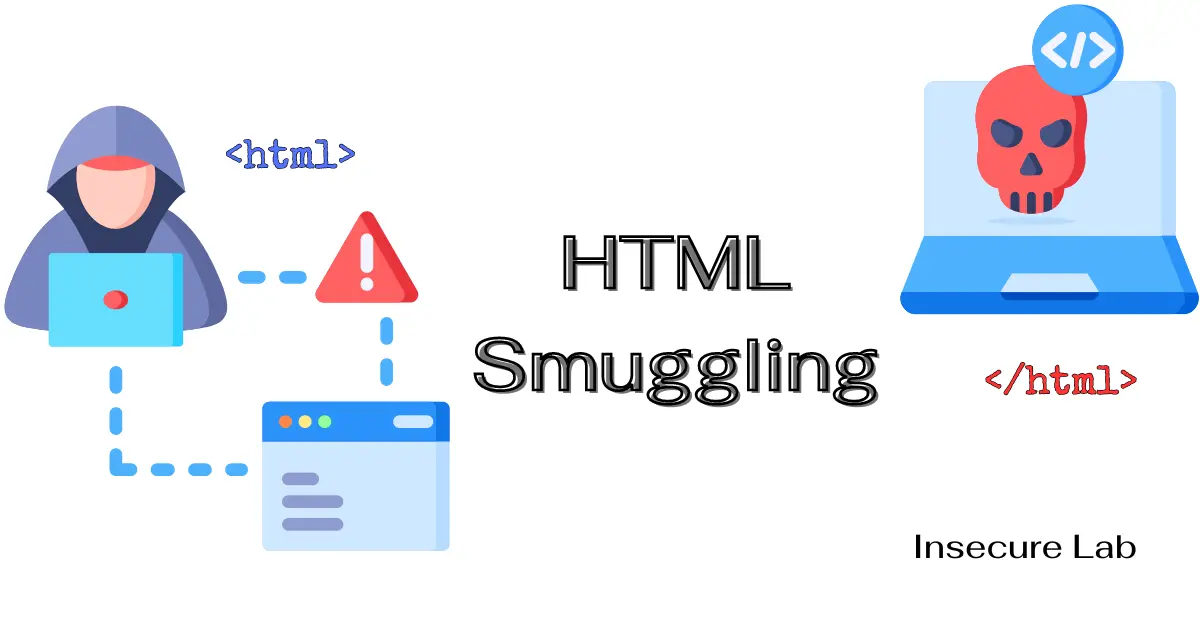Table of Contents
This guide explains what HTML Smuggling is, how it works, types of attacks, POC example, detection, prevention and mitigation techniques in cyber security.
What is HTML Smuggling?
HTML Smuggling is a technique used to bypass security mechanisms by embedding malicious payloads within HTML or JavaScript code, allowing the transfer of unauthorized files to a user’s computer through seemingly benign web pages.
The goal is to create a web page that, when visited, dynamically generates and forces the download of a malicious file without the user’s explicit consent or knowledge, effectively smuggling the file onto the user’s device.
This method exploits the inherent trust in web browsers, leveraging HTML5 and JavaScript features to create and download files dynamically. Such techniques are commonly used in phishing attacks, malware distribution, and bypassing network security measures that scan for malicious files.
Key Components
At its core, HTML Smuggling involves three main components:
- HTML5 and JavaScript: Modern web technologies that enable dynamic content creation and manipulation.
- Blob Objects: Binary Large Objects (Blob) used for storing data of files that can be created and manipulated with JavaScript.
- Data URIs: Uniform Resource Identifiers that allow resources to be embedded within web pages directly.
How HTML Smuggling Works?
HTML Smuggling primarily relies on the Data Transfer or Blob (Binary Large Object) features of HTML5 and JavaScript. These features were designed to enhance web applications by allowing the efficient transfer and manipulation of binary data (e.g., files) directly within the browser.
Attackers exploit these features to construct and download malicious files on the victim’s device when they visit a compromised or malicious web page or click on a seemingly benign link. The process can be broken down into several key steps:
- Crafting the Payload: An attacker creates a malicious file intended for the victim’s system.
- Encoding the Payload: The file is encoded (e.g., base64) to be included in a web page or a script.
- Web Page Creation: A web page is designed to include the encoded payload. JavaScript is used to decode the payload and create a Blob object representing the file to be smuggled.
- Triggering the Download: JavaScript triggers the download of the Blob object, often as soon as the page is loaded or via some user interaction, like clicking a disguised link.
Example of HTML Smuggling Attack
Let’s illustrate HTML Smuggling PoC with a basic example. In this scenario, we’ll create a benign-looking web page that, when accessed, will automatically download a text file named ‘example.txt‘.
<!DOCTYPE html>
<html lang="en">
<head>
<meta charset="UTF-8">
<title>HTML Smuggling Example</title>
</head>
<body>
<h1>Welcome to Our Site!</h1>
<button id="downloadBtn">Download Free Report</button>
<script>
document.getElementById('downloadBtn').addEventListener('click', function() {
// Step 1: Create the payload - a simple text file content
var payload = "Hello, this is a test file smuggled via HTML.";
// Step 2: Convert the payload into a Blob
var blob = new Blob([payload], { type: 'text/plain' });
// Step 3: Create a URL for the Blob
var downloadUrl = window.URL.createObjectURL(blob);
// Step 4: Create an anchor (<a>) element and trigger the download
var downloadLink = document.createElement('a');
downloadLink.href = downloadUrl;
downloadLink.download = 'example.txt';
document.body.appendChild(downloadLink);
downloadLink.click();
document.body.removeChild(downloadLink);
});
</script>
</body>
</html>In this example:
- A button labeled ‘
Download Free Report‘ is presented to the user. - When the button is clicked, JavaScript creates a Blob object containing a simple text message.
- It then dynamically creates a link (
<a>element) pointing to the Blob and simulates a click on this link, triggering the file download.
Detection Techniques
Detecting HTML smuggling attacks can be challenging due to their stealthy nature and reliance on client-side execution. However, several detection techniques can help identify and mitigate these attacks, including:
- Static Analysis: Conducting static analysis of web content for suspicious HTML or JavaScript code can help detect potential HTML smuggling attacks before they are executed on the client-side.
- Dynamic Analysis: Performing dynamic analysis of web applications by monitoring client-side interactions and network traffic can reveal anomalous behavior indicative of HTML smuggling attacks.
- Behavioral Analysis: Analyzing the behavior of web applications and services for signs of unauthorized access, data exfiltration, or other malicious activities can help detect HTML smuggling attacks in real-time.
Prevention and Mitigation
To defend against HTML Smuggling, organizations and individuals can adopt a layered cybersecurity approach that combines user awareness, security tools, and ongoing vigilance.
- Endpoint Protection: Use advanced endpoint security solutions that can detect anomalous behaviors and block malicious file executions.
- Content Disarm & Reconstruction (CDR): Implement CDR technology to remove potentially malicious content from files before they reach the end user.
- Endpoint Detection and Response (EDR): Utilize EDR solutions that monitor user activity and can identify suspicious browser behavior indicative of HTML smuggling.
- Up-to-date Browsers: Ensure that web browsers and other software are kept up-to-date to mitigate exploitation of known vulnerabilities.
- Network Monitoring: Employ network monitoring tools capable of detecting unusual data flows or unauthorized downloads.
- Disable Automatic Downloads: Configure web browsers to disable automatic downloads, requiring user approval for each download.
- User Education: Train users to recognize suspicious activities and to avoid downloading files from unknown or untrusted sources.

